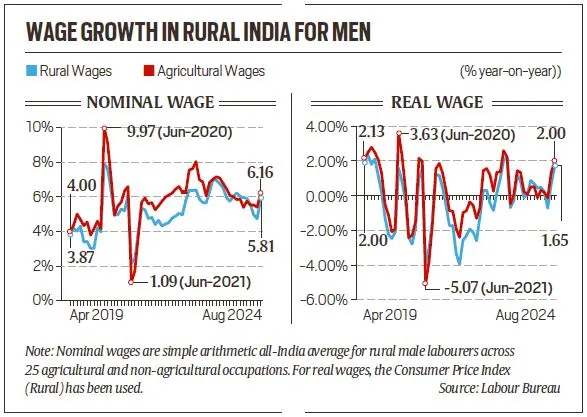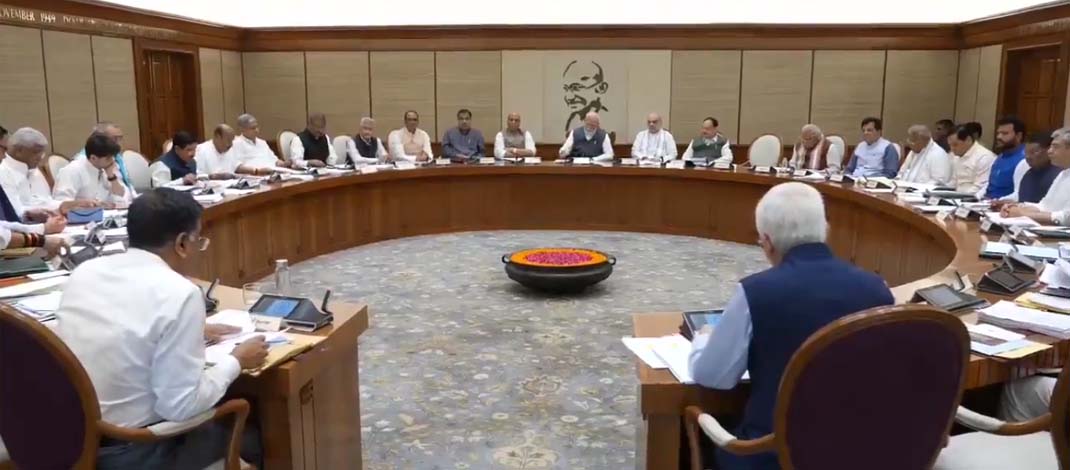- Courses
- GS Full Course 1 Year
- GS Full Course 2 Year
- GS Full Course 3 Year
- GS Full Course Till Selection
- Online Program
- GS Recorded Course
- NCERT (Recorded 500+ Hours)
- Polity Recorded Course
- Geography Recorded Course
- Economy Recorded Course
- AMAC Recorded Course
- Modern India, Post Independence & World History
- Environment Recoded Course
- Governance Recoded Course
- Science & Tech. Recoded Course
- International Relations and Internal Security Recorded Course
- Disaster Management Module Course
- Ethics Recoded Course
- Essay Recoded Course
- Current Affairs Recoded Course
- CSAT
- 5 LAYERED ARJUNA Mentorship
- Public Administration Optional
- ABOUT US
- OUR TOPPERS
- TEST SERIES
- FREE STUDY MATERIAL
- VIDEOS
- CONTACT US
Stagnant Wages in Rural India: The Impact of Increased Labor Supply
Stagnant Wages in Rural India: The Impact of Increased Labor Supply
04-11-2024

- The Indian economy has shown strong growth, averaging 4.6% from 2019-20 to 2023-24 and 7.8% in the last three fiscal years (April-March).
- The agricultural sector grew by 4.2% and 3.6% in these periods.
- However, this growth is not reflected in rural wages.
Wage Data Analysis
- The Labour Bureau collects daily wage data for 25 agricultural and non-agricultural jobs from 600 villages across 20 states.
- Labour Bureau, an attached office of the Ministry of Labour & Employment is located at Chandigarh with 9 Regional Offices at Ahmedabad, Chennai, Guwahati, Hyderabad, Indore, Jaipur, Kanpur, Kolkata and at Mumbai.
- The organisation is headed by Director General, a Higher Administrative Grade Officer from the Indian Economic Service (IES).
- key findings:
- The average nominal (actual value) growth in rural wages over the last five years was 5.2%, with agricultural wages increasing by 5.8%.
- In real terms (adjusted for inflation), average annual growth was -0.4% for rural wages and 0.2% for agricultural wages during this time.
- For the current fiscal year (April-August), overall rural wages rose 5.4% nominally and 0.5% in real terms. Agricultural wages increased by 5.7% nominally and 0.7% in real terms.
This raises an important question: Why are real rural wages not increasing, despite good growth in GDP and agriculture?
1. Rising Labour Force Participation Rates (LFPR)
One major factor is the increase in Labour Force Participation Rates among women, especially in rural areas:
- The all-India average female LFPR was 24.5% in 2018-19, rising to 41.7% in the latest Periodic Labour Force Survey for 2023-24 (July-June).
|
- Rural female LFPR went from 26.4% in 2018-19 to 47.6% in 2023-24. Meanwhile, male LFPR increased slightly from 75.5% to 78.8% overall and from 76.4% to 80.2% in rural areas.
- The Finance Ministry’s Economic Survey for 2023-24 gives credit to this sharp rise in rural female LFPR (21.2 percentage points since 2018-19) mainly to government programs like Ujjwala, Har Ghar Jal, Saubhagya, and Swachh Bharat.
- These initiatives have improved access to clean cooking fuel, electricity, drinking water, and sanitation, freeing up women's time for more productive jobs outside the home.
- However, this increase in women joining the workforce has created a larger supply of labor, which has pushed down real rural wages.
2. Shift in Employment Towards Agriculture
Despite the rise in female LFPR, most women are now working in agriculture:
- The share of agriculture in rural employment rose from 71.1% to 76.9% between 2018-19 and 2023-24.
- Although the economy is producing more goods and services, this growth is increasingly relying on machines rather than workers, resulting in fewer jobs outside of farming.
- This means that new workers, especially women, are mostly finding jobs in agriculture, where productivity (output per worker) is low.
- More labor in this sector can lead to even lower wages.
- The fact that rural non-agricultural wages have also seen little growth or even declined shows a worsening situation for those jobs.
Impact on the Economy:
- The capital-intensive growth benefits sectors like infrastructure and steel but negatively impacts labor-intensive industries, such as consumer goods.
- Capital-intensive growth is a type of economic growth that relies heavily on investment in capital goods, such as machinery, equipment, and infrastructure.
- Labor-intensive industries are those that rely heavily on human labor to produce goods or services. In these industries, labor costs makes a significant portion of the total production cost.
- When job growth and income do not keep up with GDP growth, it affects consumer spending in these sectors.
Mitigating Factors:
Despite stagnant wages, government income support programs have helped:
- According to Chief Economist at Axis Bank, 13 states and Jammu & Kashmir are implementing income support schemes for women, with annual payments estimated at around Rs 2 lakh crore, benefiting about a 5th of India's adult female population.
- Additionally, the Centre provides Rs 6,000 per year to about 11 crore farmer households, along with a 5 kg/month free grain scheme for over 81 crore people.
- For example, the Maharashtra Ladki Bahin Yojana transfers Rs 1,500 per month to women from families earning below Rs 2.5 lakh annually.
- This amount, which is about Rs 50 per day, is significant for the average rural female laborer, who earned a daily wage of Rs 311.5 from farming in August.
Conclusion
The paradox of stagnant rural wages amid strong economic growth highlights the complex situation of labor supply and demand, especially in agriculture. While more women are joining the workforce, it has led to increased competition for jobs at lower wages. Government income support programs provide crucial assistance in this challenging economic environment.
Must Check: Best IAS Coaching In Delhi
UPSC Prelims Result 2024 Out: Expected Cut Off & Other Details, UPSC Prelims 2024 Answer with Explanation, Daily Prelims Quiz, Daily Current Affairs, MONTHLY CURRENT AFFAIRS TOTAL (CAT) MAGAZINE, Best IAS Coaching Institute in Karol Bagh, Best IAS Coaching Institute in Delhi, Daily Mains Question Answer Practice, ENSURE IAS UPSC Toppers, UPSC Toppers Marksheet, Previous Year Interview Questions, UPSC Syllabus



